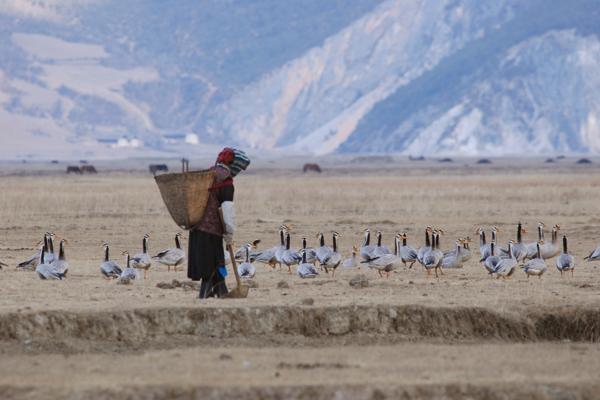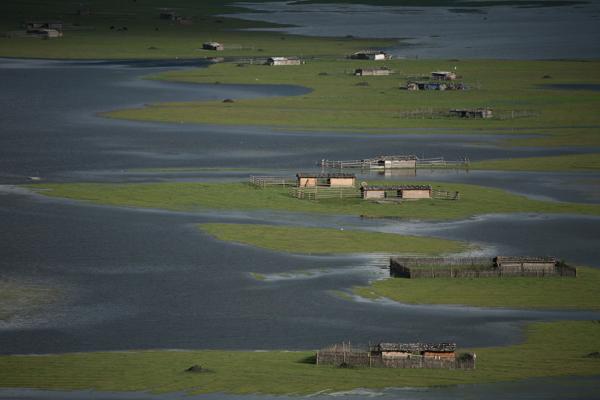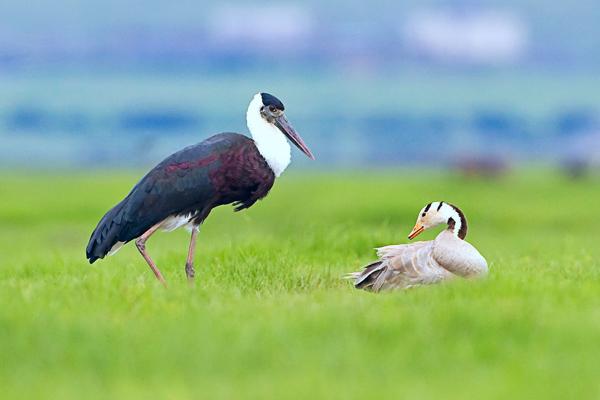
Bar-headed geese flock to the Napa Lake from the Qinghai-Tibet Plateau.[Photo/China Daily]
Birds and flowers surrounding Napa Lake, in Southeast China’s Yunnan province, make the place look like a traditional Chinese scenic painting come to life.
The water body tucked in a toe of the Hengduan Mountains’ foothills has long served as a stopover for avian visitors. About 20,000 birds flock to the area every year.
As an ornithologist, I keep my eyes not only on the skies but also on the water. Its surface spans several square kilometers in winter, when the area attracts more than 50 species. It expands during the rainy season.

The lake boasts spectacular scenery[Peng Jiansheng/For China Daily]
But dry-season swamps offer migrating birds better pickings.
Bar-headed geese and black-necked cranes flutter in from the Qinghai-Tibet Plateau. Black storks, wild ducks, coots and great crested grebes sail in from northern China in the fall and winter.
The surrounding mountains, flecked with farmhouses, offer ideal vantage points from which to watch birds. Residents have long remained protective of wildlife.
I was amazed to see whooper swans swoop over the lake. I watched spoonbills in 2001 and woolly-necked storks in 2011.
I first visited Napa Lake at the end of 1984, when bar-headed geese and various wild duck species clouded the sky while braving poachers’ guns. The scene was spectacular. I’ve visited frequently since 2005, when transportation became easier.

Black-necked cranes rank among the world’s most protected plateau birds.
They walk with royal stature, heads held high and wings spread gracefully. They even peck like aristocrats.
Their courtship is a spectacle. Males dance around females, wings casually drooping, before females dance back, wings extended. The climax comes when they take turns hopping and calling.
Females lay two eggs at a time. Food fights often lead to bloodshed. Only the strongest survive.
I made it a point to observe a family. The younger hatchling had lighter feathers and awkwardly searched for food. Parents served fish, shrimp and insects.
Black storks, roughly the same size as the cranes, started to proliferate around Napa when it became a natural reserve in the 1980s. More than 130 of the creatures spend the winter there. Their bright-red beaks and feet, black and purple bodies, and white bellies are striking.
They appeared less elegant than the cranes. They’d whoosh around to whip up food and brusquely gulp down morsels.

Yet they were graceful in flight. They glided deftly, with their necks straight and wings spread.
I saw thousands of crows near the lake in the winter of 2011. While the species flocks, it’s rare to see such mass murders.
They came to eat fish.
Napa Lake shrinks in winter.
Villagers irrigate so their flocks and herds can eat.
The rapid water-level drop leaves fish stranded.
They snap trawl from shallow water.
It’s pitiful to see so many fish die in 10 days. Even vultures can’t eat them all.
Masses rot.
I saw my first white-tailed eagles in the winter of 1991. Napa now hosts more than 30.
They mostly eat fish and ducks.
The raptors fight crows for fish. The smaller warriors unite to beat the bomber-like birds.
I once saw four crows conspire against an eagle. They seemed to have a battle plan. One agitated; one guarded that eagle; and the other two ambushed from behind.
Raptors are common.
I saw a kestrel strike like lightening and float up clutching a rat.
Steppe eagles suddenly snatch bar-headed geese and crush their heads with their talons.
These eagles also often chew into dead cattle and sheep. Their powerful maws enable them to rip open hides to gobble the insides.
Feeding seems to dumb some birds.
Himalayan griffons and cinereous vultures don’t flee approaching humans in their “food comas”.
But the avian haven is threatened by excessive tourism, overgrazing and polluted water. Napa residents account for half of Shangri-La’s population.
The sewage they produce, along with tourists’, has nurtured blue-green algae blooms, while fish are covered with sores. And climate change has brought summer droughts and winter floods.
Only if the area’s environment is protected will it remain a destination for birds and humans.
It shows all of us on Earth are all birds of a feather.
If you go
Beijing visitors can fly to Shangri-La via Chengdu or Kunming and then take an airport bus for 10-15 minutes.
This story first appeared in Chinese National Geography magazine and translated by Yang Feiyue.
